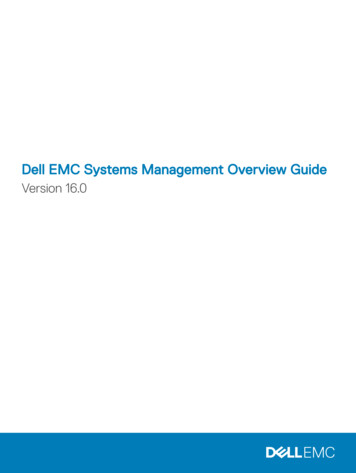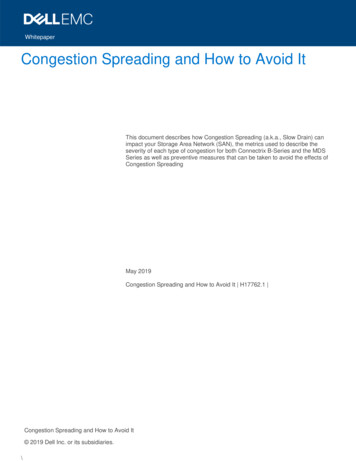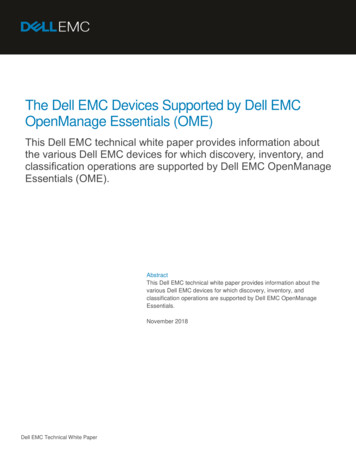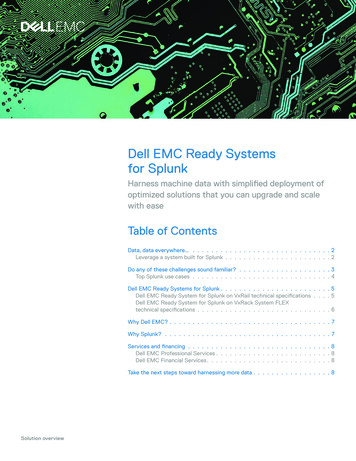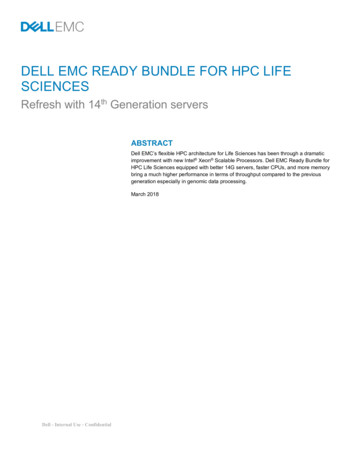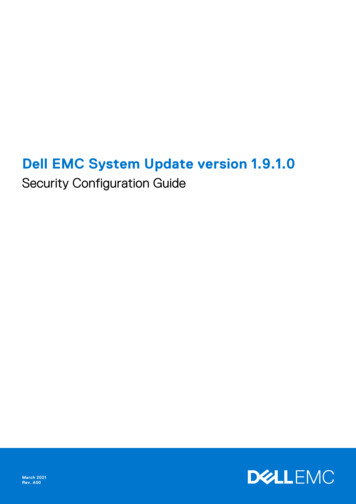
Transcription
Dell EMC System Update version 1.9.1.0Security Configuration GuideMarch 2021Rev. A00
Notes, cautions, and warningsNOTE: A NOTE indicates important information that helps you make better use of your product.CAUTION: A CAUTION indicates either potential damage to hardware or loss of data and tells you how to avoidthe problem.WARNING: A WARNING indicates a potential for property damage, personal injury, or death. 2021 Dell Inc. or its subsidiaries. All rights reserved. Dell, EMC, and other trademarks are trademarks of Dell Inc. or its subsidiaries. Othertrademarks may be trademarks of their respective owners.
ContentsFigures.4Tables. 5Chapter 1: PREFACE. 6Terms used in this document.7Chapter 2: Deployment models.8Security profiles. 8Chapter 3: Product and Subsystem Security. 9Security controls map.9Authentication. 9Access control. 9Login security settings.10Failed login behavior. 10Remote connection security.10User and credential management. 10Network security.10Network exposure.10Outbound ports. 10Inbound ports. 11Data security. 11Auditing and logging.11Serviceability. 11Product code integrity. 12Chapter 4: Miscellaneous Configuration and Management. 13Dell EMC System Update licensing.13Protect authenticity and integrity.13Manage backup and restore in Dell EMC System Update. 13Contents3
Figures14FiguresSecurity Controls Map. 9
Tables1Revision History.62Terms used in this document. 73Outbound ports.104Inbound ports. 11Tables5
1PREFACEAs part of an effort to improve its product lines, Dell EMC periodically releases revisions of its software and hardware. Somefunctions that are described in this document might not be supported by all versions of the software or hardware currently inuse. The product release notes provide the most up-to-date information about product features.Contact your Dell EMC technical support professional if a product does not function properly or does not function as describedin this document. This document was accurate at publication time. To ensure that you are using the latest version of thisdocument, go to https://www.dell.com/support.Legacy disclaimersThe information in the publication is provided as-is. Dell Technologies makes no representations or warrantiesof any kind regarding the information in the publication, and specifically disclaims implied warranties ofmerchantability or fitness for a particular purpose. In no event shall Dell Technologies, its affiliates or suppliers, be liablefor any damages whatsoever arising from or related to the information contained herein or actions that you decide to takebased thereon, including any direct, indirect, incidental, consequential, loss of business profits or special damages, even if DellTechnologies, its affiliates or suppliers have been advised of the possibility of such damages.The Security Configuration Guide intends to be a reference. The guidance is provided based on a diverse set of installed systemsand may not represent the actual risk/guidance to your local installation and individual environment. It is recommended that allusers determine the applicability of this information to their individual environments and take appropriate actions. All aspects ofthis Security Configuration Guide are subject to change without notice and on a case-by-case basis. Your use of the informationthat is contained in this document or materials that are linked herein is at your own risk. Dell reserves the right to change orupdate this document in its sole discretion and without notice at any time.Scope of the documentThis document includes information about security features and capabilities of Dell EMC System Update (DSU).AudienceThis document is intended for individuals who are responsible for managing security for Dell EMC System Update.Revision HistoryThe following table presents the revision history of this document.Table 1. Revision HistoryRevisionDateDescriptionA00March 2021Initial release of the Dell EMCSystem Update 1.9.1.0 Security GuidelineDocument.Document ReferencesIn addition to this guide, you can access the other guides available at dell.com/support . Since DSU supports an Update to theServer through iDRAC, see Integrated Dell Remote Access Controller User's Guide for any configuration-related queries. For the6PREFACE
information about supported PowerEdge Servers, see Dell EMC Systems Management - OpenManage Software Support Matrix.Go to support site, click product support - Dell EMC system Update to access the following documents: Dell EMC System Update Version 1.9 User's Guide Dell System Update 1.9 Release NotesYou can find the technical artifacts including white papers at dell.com/supportSecurity resources Dell Security Advisories (DSA) dell.com/support/security Support knowledge base (KB) articles at stem-update-dsuGetting helpContact your Dell EMC technical support professional if a product does not function properly or does not function as describedin this document. This document was accurate at publication time. To ensure that you are using the latest version of thisdocument, go to dell.com/supportReporting security vulnerabilitiesDell EMC takes reports of potential security vulnerabilities in our products very seriously. If you discover a security vulnerability,you are encouraged to report it to Dell EMC immediately. For the latest on how to report a security issue to Dell, please see theDell Vulnerability Response Policy on the Dell.com site.Topics: Terms used in this documentTerms used in this documentTable 2. Terms used in this documentTerminologyDescriptionDSUDell EMC System UpdateDUPDell EMC Update PackageiDRACIntegrated Dell Remote Access ControllerWMIWindows Management InstrumentationSSHSecure ShellPREFACE7
2Deployment modelsYou can deploy Dell EMC System Update on Microsoft Windows Server or Linux operating system through Dell Update Package(DUP) on supported Dell EMC PowerEdge servers. Dell EMC System Update supports online or offline method to deploy on theselected operating system through Dell Update Package. For more information on the deployment of Dell System Update, seeDell EMC System Update User's Guide at dell.com/supportTopics: Security profilesSecurity profilesDell EMC System Update has a default security profile for secure HTTP or HTTPS access with self-signed certificate duringinstallations. It is recommended to replace the Certificate Authority (CA) signed certificates for a better security environment.8Deployment models
3Product and Subsystem SecurityTopics: Security controls mapAuthenticationLogin security settingsUser and credential managementNetwork securityData securityAuditing and loggingServiceabilityProduct code integritySecurity controls mapDell EMC System Update is a script optimized update deployment tool that is used to apply Dell EMC updates such asapplications, firmware, and drivers for Linux and Microsoft Windows operating systems. Using DSU, identifies the availableupdates, select the relevant updates, and deploy the updates on a single system or multiple systems through operating systemsor integrated Dell Remote Access Controller(iDRAC) or iDRAC passthrough(connection to the iDRAC through redfish API to getrelevant firmware update and deploy. System Credentials (share location credentials) used for repository or system (remoteserver) access are not stored within DSU.The following figure displays the DSU security controls map:Figure 1. Security Controls MapAuthenticationAccess controlDell EMC System Update allows only administrator console and root privilege console account to perform the operation.Product and Subsystem Security9
Login security settingsFailed login behaviorDellEMC System Update (DSU) populate failed login message on console for wrong credential. For more information about failedlogin behavior of DSU, see the Dell EMC System Update User's Guide at dell.com/supportRemote connection securityDell EMC System Update uses open source library for remote connection using SSH and WMI and it does not log the credentialsmentioned for connections.User and credential managementDell EMC System Update supports HTTPS and HTTP connections.Network securityDell System Update uses a pre-configured firewall to enhance security by restricting inbound and outbound network traffic tothe TCP and UDP ports. The tables in this section lists the inbound and outbound ports that Dell System Update uses.Network exposureDell System Update uses inbound and outbound ports when communicating with remote systems.Outbound portsOutbound ports can be used by Dell System Update when connecting to a remote system.The ports that are listed in the following table are the Dell System Update outbound ports.Table 3. Outbound portsPort numberLayer 4 ProtocolService7TCP, UDPECHO22TCPSSH25TCPSMTP53UDP, TCPDNS67,68TCPDHCP80TCPHTTP88TCP, UDPKerberos111TCP, UDPONC RPC123TCP, UDPNTP161-163TCP, UDPSNMP389TCP, UDPLDAP443TCPHTTPS10Product and Subsystem Security
Table 3. Outbound portsPort numberLayer 4 ProtocolService448TCPData Protection Search Admin REST API464TCP, UDPKerberos514TCP, UDPrsh587TCPSMTP636TCP, UDPLDAPS902TCPVMware ESXi2049TCP, UDPNFS2052TCP, UDPmountd, clearvisn3009TCPData Domain REST APIInbound portsThe inbound ports that are available to be used by a remote system when connecting to Dell System Update remote.The ports that are listed in the following table are the Dell System Update inbound ports.Table 4. Inbound portsPort numberLayer 4 MIData securityDSU does not store any data in databases also from input dependencies libraries. DSU uses certificates for secure HTTP access(HTTPS). By default, DSU installs GPG keys and uses the self-signed certificate for the HTTPS secure transactions. For bettersecurity, it is recommended to use the Certificate Authority (CA) signed or custom certificates.Auditing and loggingDSU administration console generate all the relevant logs in default location or user provided location. DSU supports Log fileretention , compression and file rollover. Log file sizes are defined to 5 MB limit. A descriptive and clear log messages areprovided. For more information about Troubleshooting, Log files, see the Dell EMC System Update User's Guide available atdell.com/supportServiceabilityThe support website https://www.dell.com/support provides access to licensing information, product documentation,advisories, downloads, and troubleshooting information. This information helps you to resolve a product issue before you contactsupport team.Special login is not required to Dell EMC System Update for service personnel. If the troubleshooting bundle is not sufficient, thepersonnel can enable the root user to collect more information.Ensure that you install security patches and other updates when they are available, including the Dell EMC System Update.Product and Subsystem Security11
Product code integrityThe Dell EMC System Update software installer is signed by Dell. It is recommended that you verify the authenticity of the DellEMC System Update installer signature.12Product and Subsystem Security
4Miscellaneous Configuration andManagementTopics: Dell EMC System Update licensingProtect authenticity and integrityManage backup and restore in Dell EMC System UpdateDell EMC System Update licensingDSU has open source approvals for the internal dependencies and gets installed with the application on the box. It can also befind at opensource.dell.com/releases/DSU/ For more information about licensing of Dell EMC System Update, see the DellEMC System Update User's Guide available at dell.com/supportNOTE:Any active license can be used for Dell EMC System Update 1.9.1.0 versions. Licenses used from previous instances of DellEMC System Update or downloaded again from the Digital Locker can be used for current instances of Dell EMC SystemUpdate.Protect authenticity and integrityTo ensure product integrity, the Dell EMC System Update installation and update components are signed.To ensure communication integrity, it is recommended to use CA-signed certificate.Manage backup and restore in Dell EMC SystemUpdateFor information about backup and restore, see the Dell EMC System Update User's Guide available at https://www.dell.com/support/home/?app knowledgebaseMiscellaneous Configuration and Management13
Deployment models. You can deploy Dell EMC System Update on Microsoft Windows Server or Linux operating system through Dell Update Package (DUP) on supported Dell EMC PowerEdge servers. . 3009 TCP Data Domain REST API. Inbound ports. The inbound ports that are available to be used by a remote system when connecting to Dell System Update remote.




